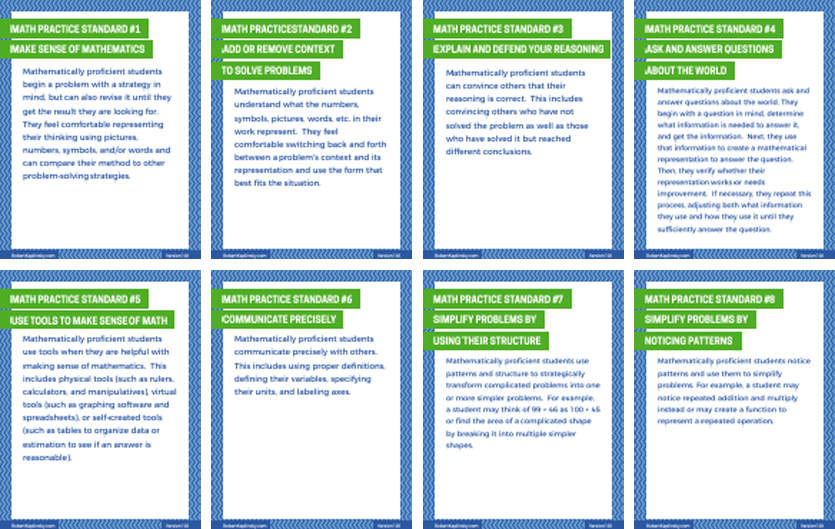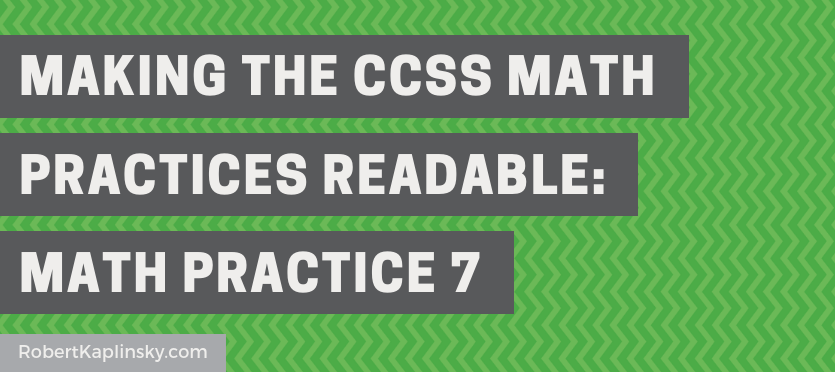This is the seventh of an eight blog post series where I’ll attempt to make a version of each of the Common Core State Standards’ Math Practices that educators, parents, and students can all understand. Simply put, the Math Practices are really tough to make sense of, which means that few educators have read them in full paragraph form and even fewer confidently understand them.
- My guiding principle comes from Antoine de Saint Exupéry who said “perfection is attained not when there is nothing more to add, but when there is nothing more to remove.” Certainly I could always add more details, but my goal is to make each standard as succinct as realistically possible and stop.
- I will make significant changes while still preserving what I believe to be each standard’s essence.
- I’ll also copy and paste the official math practice for comparison.
- I’ll add notes to explain my reasoning.
I realize that inevitably my version will also be flawed. Mainly I’m just curious to see if I can do any better. Thanks in advance for leaving me constructive criticism in the comments below so I can improve them.

Math Practice 7: Simplify problems by using their structure
Mathematically proficient students use patterns and structure to strategically transform complicated problems into one or more simpler problems. For example, a student may think of 99 + 46 as 100 + 45 or find the area of a complicated shape by breaking it into multiple simpler shapes.
Math Practice 7: Look for and make use of structure.
Mathematically proficient students look closely to discern a pattern or structure. Young students, for example, might notice that three and seven more is the same amount as seven and three more, or they may sort a collection of shapes according to how many sides the shapes have. Later, students will see 7 × 8 equals the well remembered 7 × 5 + 7 × 3, in preparation for learning about the distributive property. In the expression x2 + 9x + 14, older students can see the 14 as 2 × 7 and the 9 as 2 + 7. They recognize the significance of an existing line in a geometric figure and can use the strategy of drawing an auxiliary line for solving problems. They also can step back for an overview and shift perspective. They can see complicated things, such as some algebraic expressions, as single objects or as being composed of several objects. For example, they can see 5 – 3(x – y)2 as 5 minus a positive number times a square and use that to realize that its value cannot be more than 5 for any real numbers x and y.
- I seriously considered leaving this standard as just the first sentence. Ultimately, I decided to use a pair of examples to illustrate what I meant.
- I had considered adding even more examples, like the original standard, but I felt that it would break my guiding principle of “perfection is attained not when there is nothing more to add, but when there is nothing more to remove.”
- I struggled with the revised name for this standard as I thought about “breaking,” “transforming,” or “manipulating” it.


Robert, I teach in a sanctuary city, so I wanted to know if by any chance you have these PDFs in Spanish. Sadly, I am not bilingual.
Unfortunately, I don’t have these in any other languages. I hadn’t considered that there’d even be a demand for them, but I’ll see what I can do.
I just realized I never followed up with you. They are now available in English and Spanish. Hope you got a copy.
The example was very helpful in clarifying for me…thanks for including it!
My pleasure.